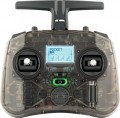External transmitter support
The option to connect an
external transmitter to the controller via micro or nano connectors allows for expanded functionality in managing RC models by supporting various communication protocols (see the relevant paragraph). For example, the default remote control operates on the TBS Crossfire protocol, while using an external transmitter allows for operation on the ELRS protocol.
Controls
The total number of controls in the remote control directly depends on the design, manufacturer, model and, most importantly, the purpose of the controller. This paragraph specifies all switches, buttons, sticks, sliders, scroll wheels and other elements used to control the RC model.
Vibration
One of the options for implementing feedback.
Vibration is the controller’s reaction to certain events occurring with the RC model. For example, it may indicate that the permissible speed or altitude limit has been exceeded, signal a strong headwind or low batteries, etc. The remote control vibrates to inform the operator about important events that should not be overlooked.
Headphone output
Audio output for connecting wired headphones.
The headphone output in the design of remote controls is usually represented by a classic mini-Jack connector (3.5 mm).
This interface is used to listen to sound signals and voice notifications directly through headphones. This may be important for providing privacy (without attracting attention from others), better sound insulation from external noise, making commands more clearly audible, etc.
Bluetooth simulator
The ability to use the remote control as a
Bluetooth simulator - to control virtual RC models and improve skills in mobile simulators. Using appropriate software for a smartphone or tablet, the controller can be used to simulate the real behavior of RC equipment without the need to go to the field or site.
In the box
—
Cover/case. Case for storing and transporting the controller. Cases are called soft cases - they are designed mainly to protect against dirt. Cases are made of hard materials - they are more bulky, but they are able to protect the remote control from impacts and shocks.
—
Protection of gimbals/sticks. Protective covers or casings that cover the controller's control elements (in particular, sticks) and prevent them from being accidentally pressed. Such devices will come in handy for safely storing and carrying the remote control.
—
A set of springs for suspensions. These controller gimbal kits typically come with several different spring options, allowing you to select the appropriate control stiffness based on the user's individual preferences. This provides greater flexibility and the ability to customize the control panel to suit specific needs and conditions of use.
-
Protective glass. Glass or transparent film to protect the remote control screen from scratches, dirt and mechanical damage. Protective glasses are tasked with keeping the controller display in good condition. This is especially important on models with touchscreens or color TFT panels, where scratches or damage can negatively affect the quality of the information displayed.

